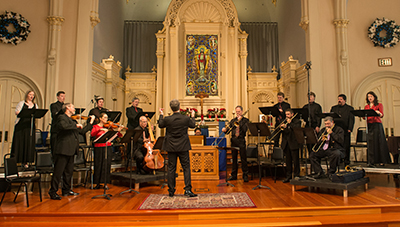Examiner Review: Magnificat’s Performance of Cavalli’s Messa Concertata
 This review by Stephen Smoliar was posted at Examiner.com on December 21, 2014.
This review by Stephen Smoliar was posted at Examiner.com on December 21, 2014.
As was the case last year, the San Francisco Early Music Society hosted the first concert in the 2014–2015 season of Magnificat yesterday afternoon at St. Mark’s Lutheran Church. Also following last year’s plan, Director Warren Stewart prepared a recreation of the entire service for the third Mass on Christmas Day as it might have been celebrated at St. Mark’s Basilica in the middle of the seventeenth century. Last year the five sections of the Ordo Missae (the “Ordinary” of the Mass) were pieced together from compositions by Claudio Monteverdi and Giovanni Gabrielli composed between 1610 and 1641. This year the core of the performance was an entire mass setting, Missa concertata, composed by Francesco Cavalli in 1656.
Cavalli is no stranger to opera lovers in San Francisco. He wrote 41 operas, 27 of which have been preserved to the present day. He seems to have been a favorite choice when it came to composing operas to be performed during the celebration of the pre-Lenten carnival. He could turn even the most serious scenario (such as the relationship between Jason and Medea) into raucously ribald comedy.
However, Cavalli’s first appointment in Venice was as a singer for Monteverdi at St. Mark’s. As a result Cavalli also built up a portfolio, somewhat more modest, of sacred music. This was particularly distinguished by his own intricate approach to counterpoint, which contrasted sharply with his operas that consisted almost entirely of arias, often with provocative texts.
Yesterday’s Mass setting was in eight parts for double choir. All parts were sung by solo voices, and the two choirs faced each other in “mirror image” on opposite sides of the altar. Thus soprano Clara Rottsolk on the left directly faced soprano Jennifer Paulino on the right. The other left-right pairings were altos Andrew Rader and Tim Galloway, tenors Christopher LeCluyse and Daniel Hutchings, and basses Robert Safford and Peter Becker. Seated in front of the left choir were two violins (Rob Diggins and Jolianne von Einem) and a violone (John Dornenburg), while three sackbuts, Richard Van Hessel (alto), Erik Schmalz (tenor), and Mack Ramsey (bass), occupied the front space on the right. Between these two groups sat organist Yuko Tanaka.
Over the course of the Mass sections, Cavalli deployed his resources in a variety of different combinations, rather than adhering simply to antiphonal effects. Of greatest interest were the passages allocated to the two voices in the same range, usually singing homophony in parallel thirds. As a result there was considerable diversity in the textures that Cavalli wove with this voices, with each texture given its own complementary instrumental setting. All this made for an interpretation of the Mass text with decidedly unique qualities having virtually no connection to Cavalli’s more popular reputation as an opera composer.
The service also included two motets. The first, Claudio Monteverdi’s “Ecce sacrum paratum convivium” (behold the holy feast is prepared for you) was sung by Rottsolk for the Elevation. The Communion was replaced by a duet for soprano (Paulino) and alto (Rader), also composed by Cavalli in 1656, “O bone Iesu, o Iesu amabilis” (Good Jesus, loving Jesus). Both motets were accompanied only by organ. The “Deo gratias” at the conclusion was replaced by Gabrieli’s 1585 setting of “O magnum mysterium” (O great mystery). For this final selection the choirs were reconfigured with SSAB on the left facing TTAB on the right. The rest of the service was delivered as plainchant with LeCluyse intoning the texts of the celebrant and Rader the Scripture texts for the deacon.
There were also two instrumental selections, one composed by Biagio Marini in 1655 and the other by Massimiliano Neri in 1651. Marini’s selection was particularly memorable for using the first five steps of the major scale (do-re-mi-fa-sol) as its theme. While there was nothing unusual about this choice of thematic material, it happened to reflect Cavalli’s choice for setting “Gloria in excelsis Deo.” (Marini’s music was performed between the Gloria and Credo sections.) Those whose preferences run to Ludwig van Beethoven will also recognize this as the opening theme for the Gloria text in his Opus 123 “solemn” Mass setting, although it is unlikely that Beethoven knew very much about either Cavalli or any of the other activities in seventeenth-century Venice. (Neither of these topics shows up in Alexander Wheelock Thayer’s comprehensive biography.)
As usual, the execution of both vocal and instrumental music was up to the high standards that Stewart sets for Magnificat performances. It also seemed as if Stewart was going for more phrase-by-phrase expressiveness yesterday afternoon, almost as if he wished to recognize the spirit of Cavalli’s operatic style, if not the worldliness of his technique. The entire service was, in all likelihood, a journey of discovery for almost everyone in the audience. Bringing yet another dimension to seventeenth-century musical practices at St. Mark’s, that journey was definitely worth taking.